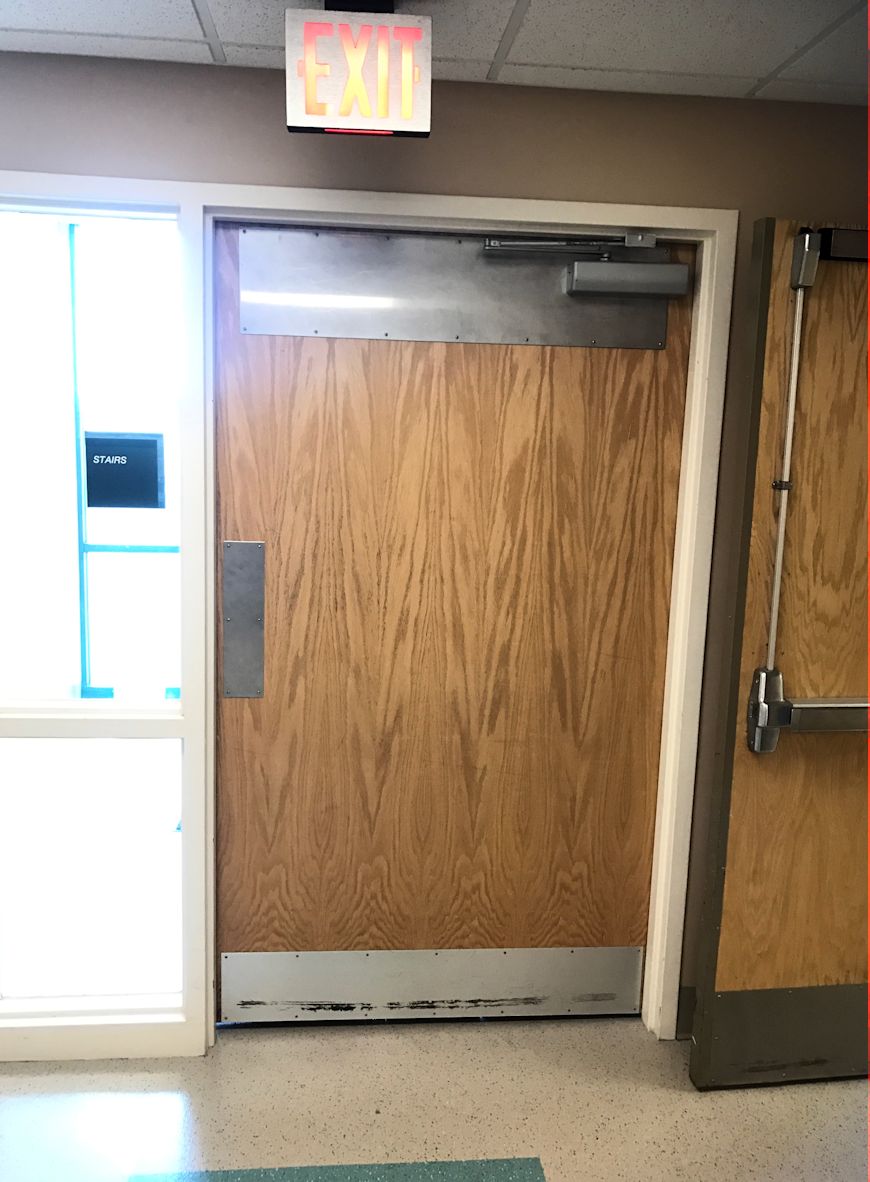 This fire door assembly has a few issues, one of which is the obvious repair at the top rail. I am often asked to provide “proof” that this type of repair is unacceptable. Often the most direct route to find that evidence is to ask the door manufacturer for documentation of whether this is allowed by their listing procedures.
This fire door assembly has a few issues, one of which is the obvious repair at the top rail. I am often asked to provide “proof” that this type of repair is unacceptable. Often the most direct route to find that evidence is to ask the door manufacturer for documentation of whether this is allowed by their listing procedures.
NFPA 80 may not specifically address these details in the standard, but in some cases the NFPA 80 Handbook will have information to help establish the intent of the standard. For example, there are a few mentions of using plates to cover old holes…
It is important to understand that NFPA 80 requires unused holes to be filled, not merely covered. For example, installing a stainless steel push plate between lock trim and the face of a door conceals unused holes, but it does not restore the fire protection properties of the door itself.
Inspectors need to be able to recognize telltale signs that field modifications have been made to a door frame or door. Rough-edged and/or irregular-shaped cutouts, auxiliary cover plates, and unusual fasteners are some of the telltale signs that indicate field modifications have been made.
Caulking (including caulks for fire barrier penetrations) and other such putties/fillers are not an acceptable method for repairing most fire doors, and neither is placing a protection plate over the holes in doors and frames. It is important to research the construction of the door in question and seek direction as to how to correctly repair it before attempting to repair a damaged fire door.
So, if you can’t find a specific reference in NFPA 80, check the NFPA 80 Handbook, and of course you can always visit iDigHardware or contact me. Keep in mind that the codes and standards don’t always reflect the newest changes to products and methods (for example, the reference to caulk), so I try to make that information available here and work to incorporate it into the codes and standards during the next code development cycle.
Thank you to Hal Kelton of DOORDATA Solutions for today’s Fixed-it Friday photo!
You need to login or register to bookmark/favorite this content.






Definitely a pain to be asked ‘after the fact’/forensic questions about repairs that are difficult to see. My first inclination was that this isn’t even fire rated because of the lack of latch, but the “Stair” sign made me pause. Some stairs don’t require fire rated enclosure, and this could be one of those conditions, with the push/pull door just providing for visual or acoustic client needs. In that case there may be no real problem with maintenance repairs.
I also thought “hey, maybe someone reused this door leaf upside down from where it was previously and added a new bottom kickplate…” LOL
I double-checked with Hal, and it is a labeled door. I don’t know if it originally had a latch or not.
– Lori
I wonder why that stairwell door doesn’t have positive latching?
That’s one of the “other” issues. Along with the signage on the glass.
– Lori
signage on glass, so what is issue with that, it would either be there or on door, i know the sign wont be 5% of area, so ?
thanks!
Hi Richard –
NFPA 80 prohibits signage from being installed on glazing that is a part of a fire door assembly. The 2016 edition made a slight change to this paragraph: “4.1.4.3* Signs shall not be installed on
fire protection–rated
glazing in fire doors,” so I think signage can be mounted to fire resistance rated glazing, but that type of glazing is not very common.
– Lori
Kickplate for those walking upside-down on the ceiling, of course. Hope they don’t trip on the exit sign or closer
as discussed before a door with a label does not make it a fire door, I was concerned with the fire door assumption wiht the large glass to the left of the door
I double-checked with Hal and this door is a 20-minute door. This amount of glass would be acceptable for a 20-minute door, but as I said with regard to one of the other comments – 20 minute doors are not typical for stairs. There may be another door between this one and the actual stairwell, but the door in the photo is a 20-minute fire door assembly.
– Lori
I take that is glass or similar next to the door??
I am wondering if you walk through this door,
If it leads to an actual stairwell???
Yes – it is a glass sidelight. Hal said the door has a 20-minute label which is unusual for a stair door so maybe there’s another door between this door and the actual stairwell.
– Lori
If the door has a label does the frame have one as well? Could they possibly put a labeled stock door into a non-rated opening?
Apparently a rating is required in this location – the facility is in the process of addressing the issues.
– Lori